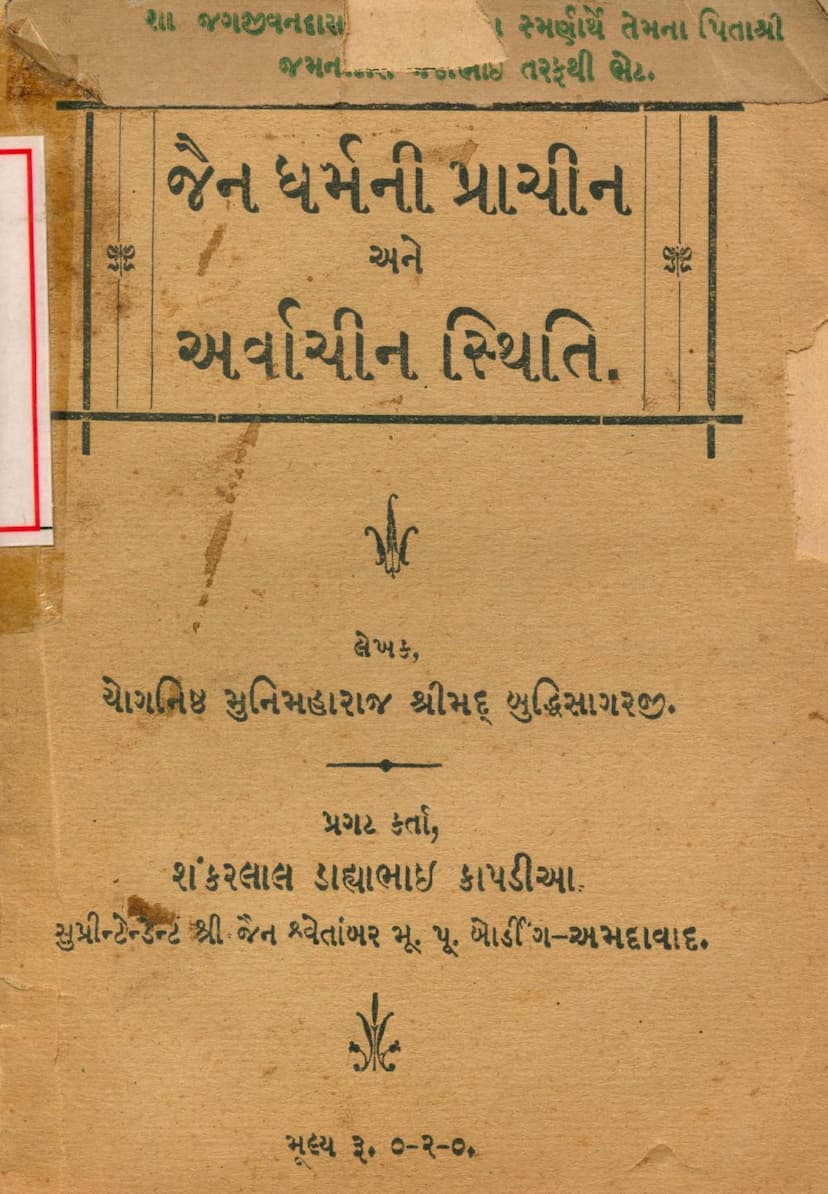Jain Dharmni Prachin Ane Arvachin Sthiti
Added to library: September 2, 2025

Summary
Here's a comprehensive summary of the Jain text "Jain Dharmni Prachin Ane Arvachin Sthiti" by Buddhisagar:
This book, authored by the esteemed Muni Maharaj Shrimad Buddhisagarji, delves into the ancient and modern state of Jainism. Published by Shankarlal Dahyabhai Kapadia, it aims to provide historical context and insights into the development and status of the Jain faith.
Core Themes and Content:
The book primarily focuses on establishing the antiquity and extensive reach of Jainism. It argues that Jainism is an eternal religion, predating many other faiths and having a significant presence across various ancient civilizations.
Key Arguments and Evidence Presented:
- Deep Antiquity: The author asserts that Jainism has existed since time immemorial, tracing its origins back to Rishabhadeva Bhagwan. It claims that Jainism was prevalent in numerous countries, including Afghanistan, Turkestan, China, and Tartary, during the time of Rishabhadeva and subsequent Tirthankaras.
- Involvement of Historical Figures: The text draws connections between Jainism and prominent figures from Indian epics and history, suggesting that rulers and individuals like Bharat, Bahubali, Rama, Lakshmana, Ravana, Bali, Sugriva, Hanuman, Janak, Shripal, Krishna, and the Pandavas were Jain or had strong Jain leanings. It cites Jain Ramayanas and texts like the Shatrunjaya Mahatmya to support these claims.
- Spread and Influence: The book highlights the influence of Jainism across various regions of India and beyond, mentioning specific locations like Lanka, Sripal's travels, and coastal areas like Konkan. It points to archaeological evidence like Jain temples and sculptures as proof of its historical presence.
- Relationship with Other Religions: The author discusses the historical context of Jainism alongside other major Indian religions like Vedic Dharma and Buddhism. It argues that Jainism is older than Vedic Dharma, citing the ancient Jain Grammarian Shakatayana, who predates Panini. It also refutes the notion that Buddhism originated from Jainism, asserting their distinct origins and Jainism's greater antiquity.
- Role of Jain Scholars and Texts: The book emphasizes the significant contributions of Jain Acharyas and scholars in various fields, particularly grammar, with Shakatayana, Jainendra, and Hemachandra being mentioned as key figures. It also points to the vast body of Jain literature as evidence of its rich intellectual tradition.
- Social and Political Impact: The text highlights the role of Jainism in shaping the social and political landscape of ancient India. It suggests that many Jain kings promoted the faith and that the four Varnas (Brahmin, Kshatriya, Vaishya, Shudra) embraced Jainism. It also touches upon the decline of Jainism's political influence over time.
- Devotional Practices and Temples: The book mentions the significance of Jain Tirthas (pilgrimage sites) like Shatrunjaya, Girnar, and Sametshikhar, and the extensive construction of Jain temples, reflecting the faith's historical grandeur and the wealth of its followers.
- Causes of Decline and Suggestions for Revival: A significant portion of the book is dedicated to analyzing the reasons for Jainism's decline. These include internal schisms (like the emergence of different Gachhas and sects), lack of unity among Acharyas, conflicts with other religions (particularly Vedic Dharma and later Islam), insufficient propagation of Jain principles, and the adoption of certain practices that diluted the core tenets. The author concludes by offering numerous suggestions for the revival of Jainism, emphasizing the need for:
- Establishing Jain Gurukulas and educational institutions.
- Consistent and widespread preaching of Jain philosophy.
- Promoting inter-caste harmony and inclusivity within Jainism.
- Fostering unity and collaboration among different Jain sects and Acharyas.
- Promoting Jain scholars and writers to defend and propagate the faith.
- Reviving lost scriptures and translating them into various languages.
- Encouraging charitable activities and ethical conduct.
- Addressing internal disputes and promoting a unified approach.
- Reaching out to communities that have strayed from Jainism and encouraging their return.
Overall Significance:
"Jain Dharmni Prachin Ane Arvachin Sthiti" is a significant work that aims to reclaim and highlight the historical grandeur, societal impact, and philosophical depth of Jainism. It serves as a call to action for the Jain community to understand their rich heritage, address the causes of their religion's decline, and work towards its resurgence in the modern era. The book is a testament to the author's deep knowledge of Jain history and his earnest desire for the faith's continued prosperity.